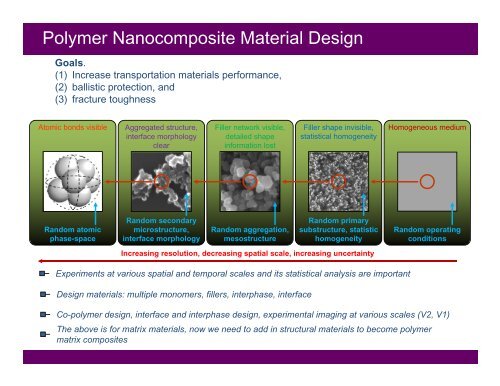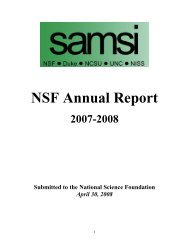Wing Kam Liu* and Wei Chen, Northwestern University ... - SAMSI
Wing Kam Liu* and Wei Chen, Northwestern University ... - SAMSI
Wing Kam Liu* and Wei Chen, Northwestern University ... - SAMSI
Create successful ePaper yourself
Turn your PDF publications into a flip-book with our unique Google optimized e-Paper software.
Polymer Nanocomposite Material Design<br />
Goals.<br />
(1) Increase transportation materials performance,<br />
(2) ballistic protection, <strong>and</strong><br />
(3) fracture toughness<br />
Atomic bonds visible Aggregated structure,<br />
interface morphology<br />
clear<br />
R<strong>and</strong>om atomic<br />
phase-space<br />
R<strong>and</strong>om secondary<br />
microstructure,<br />
interface morphology<br />
Filler network visible,<br />
detailed shape<br />
information lost<br />
R<strong>and</strong>om aggregation,<br />
mesostructure<br />
Design materials: multiple monomers, fillers, interphase, interface<br />
Filler shape invisible,<br />
statistical homogeneity<br />
R<strong>and</strong>om primary<br />
substructure, statistic<br />
homogeneity<br />
Increasing resolution, decreasing spatial scale, increasing uncertainty<br />
Experiments at various spatial <strong>and</strong> temporal scales <strong>and</strong> its statistical analysis are important<br />
Homogeneous medium<br />
R<strong>and</strong>om operating<br />
conditions<br />
Co-polymer design, interface <strong>and</strong> interphase design, experimental imaging at various scales (V2, V1)<br />
The above is for matrix materials, now we need to add in structural materials to become polymer<br />
matrix composites

















